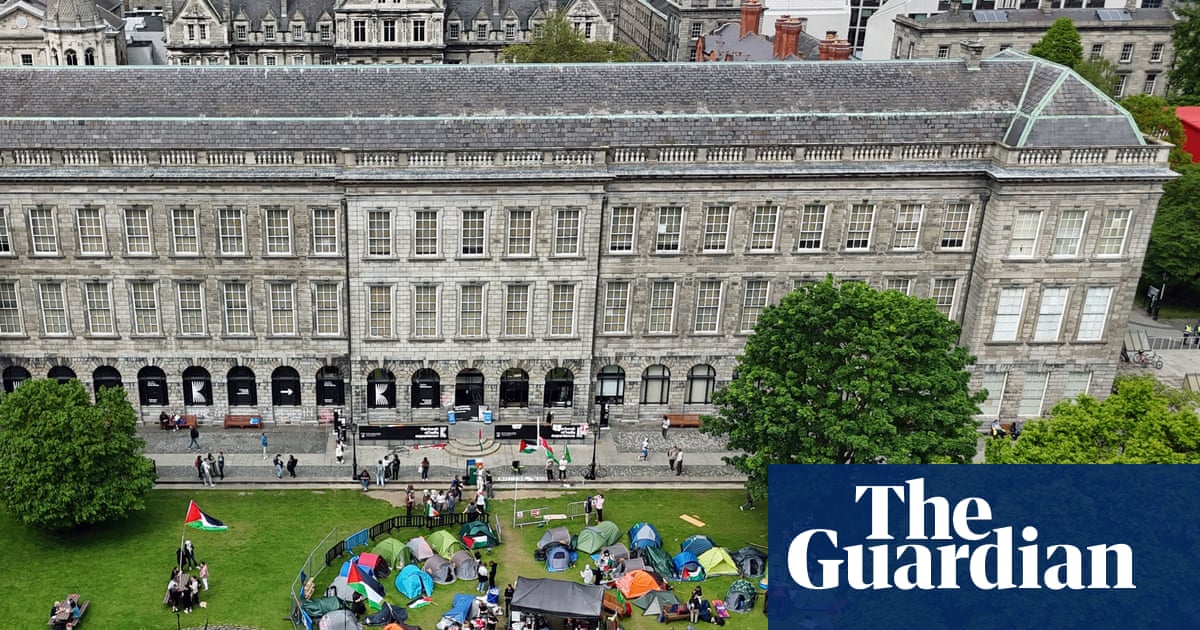Clothes discarded by UK consumers and shipped to Ghana have been found in a huge rubbish dump in protected wetlands, an investigation has found.
Reporters for Unearthed working with Greenpeace Africa found garments from Next in the dump and other sites, and items from George at Asda and Marks & Spencer washed up nearby.
The dumps are in an internationally recognised wetland that is home to three species of sea turtle. Local people complain that their fishing nets, waterways and beaches are clogged with synthetic fast-fashion garments exported to Ghana from the UK and Europe.
In a third dump on the banks of the river leading to the conservation site, Unearthed reporters found garments from M&S, Zara, H&M and Primark.
The fashion labels acknowledged that the industry faces challenges in processing textile waste. M&S, George and Primark said they ran take-back schemes intended to help address the issue. H&M, Zara and George said they would support an extended producer responsibility (EPR) framework to hold labels accountable for their products’ end-of-life impact.
The global fast-fashion overspill has overwhelmed Ghana’s capital, Accra, with tangled clothes carpeting city beaches and lining canals.
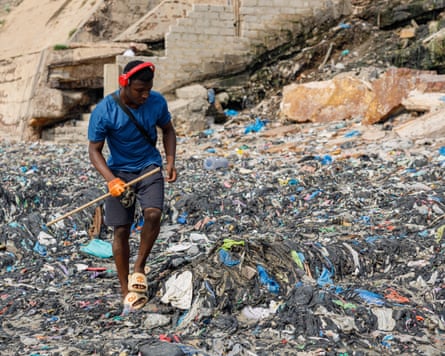
New dump sites are springing up beyond urban areas and in conservation areas that are vital for wildlife, the investigation found. Reporters also found textile waste, including UK labels, tangled in vegetation, half-buried in sand, and in waste washed up at a beach resort where a manager said he burned piles of clothes every week.
At the heart of Ghana’s used clothing trade is Kantamanto, one of the world’s biggest secondhand clothes markets. It receives more than 1,000 tonnes of clothes every week, but one trader said the quality was worse than it used to be. “In the past, we had good clothes to sell to take care of our families, but these days the used clothes we find in the bales are not fit for resale,” said Mercy Asantewa. “They are poorly made and are already falling apart when we open the bales.”
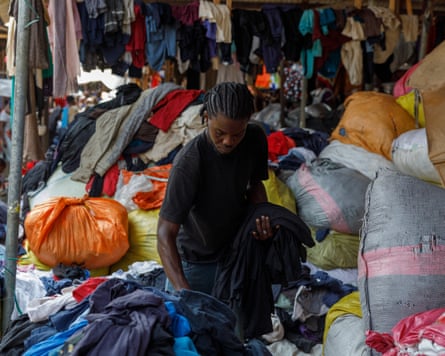
There is only one engineered dump site in the region, and another is being built. The head of Accra’s waste management department, Solomon Noi, calculates that 100 tonnes of garments leave the market daily as waste. The city is able to collect and process just 30 tonnes.
“The remaining 70 tonnes end up in waste dumps, drains, lagoons, wetlands and the sea and other environmentally sensitive places,” he said.
UK consumers discard about 1.5m tonnes of used textiles every year. Many do not get recycled. About 730,000 tonnes a year are incinerated or go into landfills. Of the 650,000 tonnes sent to be reused and recycled, 420,000 – more than two-thirds – are exported. Ghana receives more than any other country.
A group of Ghanaian traders visited Brussels in 2023 and argued that the EU should introduce EPR legislation to hold fashion companies accountable for the end-of-life impact of their products. The UK’s Textile Recyclers Association has asked the government to consider something similar.

Ghana’s Densu delta is designated a site of international importance under the intergovernmental Ramsar convention on wetlands. Endangered leatherback and green turtles lay their eggs there, and the mudflats also support rare roseate terns, which migrate from the UK, and curlew sandpipers.
Unearthed’s reporters found two recently opened dump sites in the wetland’s protected area and a third dump upstream on the banks of the Densu.
Properly engineered landfills include a lined bottom, a system for collecting and treating leachate, groundwater monitoring, gas extraction and a cap system. Drone footage of the Akkaway dump, the newest site, shows a large area of the wetlands where the vegetation had been removed. Piles of waste sit on bare earth, close to lagoons and streams, with no lining or other visible pollution mitigation systems.
An official from the local government, the Weija Gbawe municipal assembly, told a reporter that it was in charge of the Akkaway dump and supervised the work there. Siting a new dump site in protected wetlands, however, appears to violate Ghana’s environmental policy and landfill guidelines, and the country’s obligations under the Ramsar convention.
The assembly did not respond to a formal request for comment.
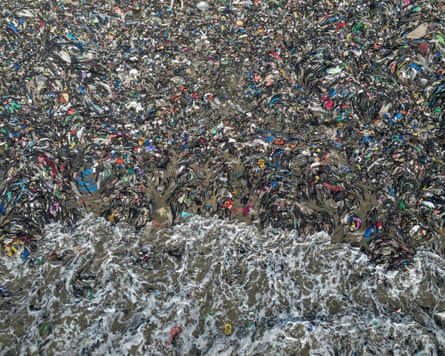
People who depend on the wetlands for their livelihoods said they were worried about the impact of the pollution. Seth Tetteh, 31, has lived near the delta for seven years. “It’s only since three years ago that they started dumping the borla [the waste] further upstream. So when you start fishing and cast your net, it brings in fish, clothes and other things, so … the fishermen … find it very tedious,” he said.
“Before, you could drink [the river water]. But now, when you go, you can’t drink it. The water is a bit black.”
Residents near the upstream dump, called Weija Ashbread, told reporters that before the site existed, the area was mostly wild. . There were “alligators, bush cats … all kinds of birds and rabbits too”, said Ibrahim Sadiq, 19, a student who lives nearby. Now when it rains “there are so many mosquitoes and the smell, it’s very bad”.
An M&S spokesperson said the company did not send excess clothing to any other country or landfill, but offered customers
“options to give their clothes another life with our recently launched repair service by Sojo, and with our in-store take-back recycling schemes with partners such as Oxfam for clothing and Handle for beauty products, as part of our plan A to reduce our impact on the planet”.
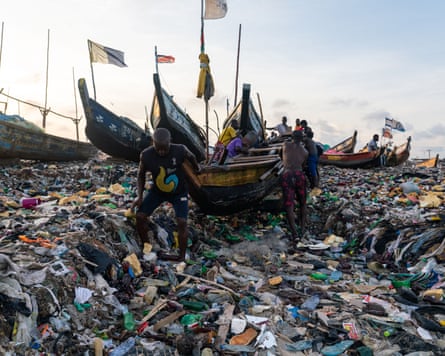
A spokesperson for George, Asda’s clothing brand, said there had been no increase in the volume of textiles produced or the number of annual fashion seasons it put out over the past 10 years, and that they had more than 800 recycling banks and a take-back scheme.
“We have a zero-waste policy, which applies to our total business,” the spokesperson said. “We would be supportive of exploring a textile EPR, providing any fees generated are used to improve the recycling infrastructure in the UK.”
A statement from Primark said: “We don’t authorise any of the clothing collected through our customer textile takeback scheme or any of our unsold stock to be sent to Ghana or anywhere else in Africa … We know that no single company can solve the issue of textile waste alone. Real progress will only come if the industry comes together. ”
H&M acknowledged that the industry faced challenges such as a lack of end-of-life solutions and fully scaled recycling solutions for discarded textiles. A spokesperson said: “While this is an industry-wide challenge, we acknowledge our role in contributing to the problem, notably when our products reach markets with inadequate or no waste management or recycling infrastructures.”
A spokesperson for Zara’s parent company, Inditex, said Zara would support an EPR policy mandated by the government: “We believe that advancing toward common legislation in this field will establish a unified framework that sets the same rules for all players. We understand that the separate collection of textile waste is the foundation of a circular model. That is why we not only promote new textile recycling technologies but also develop the necessary capabilities to make them feasible.”
Next did not respond to a request for comment.
-
Additional reporting by Viola Wohlgemuth and Richa Syal

 2 months ago
39
2 months ago
39

















